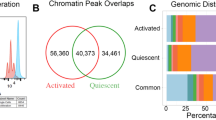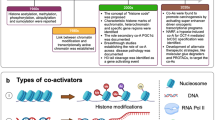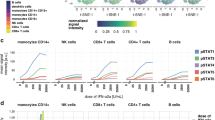Abstract
The blueprint for cellular diversity and response to environmental change is encoded in the cis-acting regulatory sequences of most genes. Deciphering this ‘cis-regulatory code’ requires multivariate data sets that examine how these regions coordinate transcription in response to diverse environmental stimuli and therapeutic treatments. We describe a transcriptional approach that profiles the activation of multiple transcriptional targets against combinatorial arrays of therapeutic and signal transducing agents. Application of this approach demonstrates how cis-element composition and promoter context combine to influence transcription downstream of mitogen-induced signaling networks. Computational dissection of these transcriptional profiles in activated T cells uncovers a novel regulatory synergy between IGF-1 and CD28 costimulation that modulates NF-κB and AP1 pathways through signaling cascades sensitive to cyclosporin A and wortmannin. This approach provides a broader view of the hierarchical signal integration governing gene expression and will facilitate a practical design of combinatorial therapeutic strategies for exploiting critical control points in transcriptional regulation.
This is a preview of subscription content, access via your institution
Access options
Subscribe to this journal
Receive 6 print issues and online access
$259.00 per year
only $43.17 per issue
Buy this article
- Purchase on Springer Link
- Instant access to full article PDF
Prices may be subject to local taxes which are calculated during checkout









Similar content being viewed by others
Abbreviations
- CSA:
-
cyclosporin A
- IL2:
-
interleukin 2
- NFAT/AP1:
-
nuclear factor of activated T cells
- PC:
-
principal component
- PCA:
-
principal component analysis
- PHA:
-
phytohemagglutinin
- PI3:
-
phosphatidyl-inositol-3 phosphate
- PMA:
-
phorbol myristate acetate
- SOM:
-
self-organizing maps
References
Venter JC, Adams MD, Myers EW, Li PW, Mural RJ, Sutton GG et al. The sequence of the human genome. Science 2001; 291: 1304–1351.
Levine M, Tjian R . Transcription regulation and animal diversity. Nature 2003; 424: 147–151.
Michelson AM . Deciphering genetic regulatory codes: a challenge for functional genomics. Proc Natl Acad Sci USA 2002; 99: 546–548.
Remenyi A, Scholer HR, Wilmanns M . Combinatorial control of gene expression. Nat Struct Mol Biol 2004; 11: 812–815.
Smith JL, Freebern WJ, Collins I, De Siervi A, Montano I, Haggerty CM et al. Kinetic profiles of p300 occupancy in vivo predict common features of promoter structure and coactivator recruitment. Proc Natl Acad Sci USA 2004; 101: 11554–11559.
Butscher WG, Haggerty CM, Chaudhry S, Gardner K . Targeting of p300 to the interleukin-2 promoter via CREB-Rel cross-talk during mitogen and oncogenic molecular signaling in activated T-cells. J Biol Chem 2001; 276: 27647–27656.
Butscher WG, Powers C, Olive M, Vinson C, Gardner K . Coordinate transactivation of the interleukin-2 CD28 response element by c-Rel and ATF-1/CREB2. J Biol Chem 1998; 273: 552–560.
Nel AE . T-cell activation through the antigen receptor. Part 1: signaling components, signaling pathways, and signal integration at the T-cell antigen receptor synapse. J Allergy Clin Immunol 2002; 109: 758–770.
Jain J, Loh C, Rao A . Transcriptional regulation of the IL-2 gene. Curr Opin Immunol 1995; 7: 333–342.
Shapiro VS, Truitt KE, Imboden JB, Weiss A . CD28 mediates transcriptional upregulation of the interleukin-2 (IL-2) promoter through a composite element containing the CD28RE and NF-IL-2B AP-1 sites. Mol Cell Biol 1997; 17: 4051–4058.
Hentsch B, Mouzaki A, Pfeuffer I, Rungger D, Serfling E . The weak, fine-tuned binding of ubiquitous transcription factors to the Il-2 enhancer contributes to its T cell-restricted activity. Nucleic Acids Res 1992; 20: 2657–2665.
Nel AE, Slaughter N . T-cell activation through the antigen receptor. Part 2: role of signaling cascades in T-cell differentiation, anergy, immune senescence, and development of immunotherapy. J Allergy Clin Immunol 2002; 109: 901–915.
Weiss A, Imboden J, Shoback D, Stobo J . Role of T3 surface molecules in human T-cell activation: T3-dependent activation results in an increase in cytoplasmic free calcium. Proc Natl Acad Sci USA 1984; 81: 4169–4173.
Thompson CB, Lindsten T, Ledbetter JA, Kunkel SL, Young HA, Emerson SG et al. CD28 activation pathway regulates the production of multiple T-cell-derived lymphokines/cytokines. Proc Natl Acad Sci USA 1989; 86: 1333–1337.
June CH, Riley JL . The CD28 family: a T cell rheostat for therapeutic control of T cell activation. Blood 2005; 105: 13–21.
Yui MA, Hernandez-Hoyos G, Rothenberg EV . A new regulatory region of the IL-2 locus that confers position-independent transgene expression. J Immunol 2001; 166: 1730–1739.
Eisen MB, Spellman PT, Brown PO, Botstein D . Cluster analysis and display of genome-wide expression patterns. Proc Natl Acad Sci USA 1998; 95: 14863–14868.
McGuire KL, Iacobelli M . Involvement of Rel, Fos, and Jun proteins in binding activity to the IL-2 promoter CD28 response element/AP-1 sequence in human T cells. J Immunol 1997; 159: 1319–1327.
Smith JL, Collins I, Chandramouli GV, Butscher WG, Zaitseva E, Freebern WJ et al. Targeting combinatorial transcriptional complex assembly at specific modules within the IL-2 promoter by the immunosuppressant SB203580. J Biol Chem 2003; 278: 41034–41046.
Lee JC, Kumar S, Griswold DE, Underwood DC, Votta BJ, Adams JL . Inhibition of p38 MAP kinase as a therapeutic strategy. Immunopharmacology 2000; 47: 185–201.
Ho S, Clipstone N, Timmermann L, Northrop J, Graef I, Fiorentino D et al. The mechanism of action of cyclosporin A and FK506. Clin Immunol Immunopathol 1996; 80: S40–S45.
Tamayo P, Slonim D, Mesirov J, Zhu Q, Kitareewan S, Dmitrovsky E et al. Interpreting patterns of gene expression with self-organizing maps: methods and application to hematopoietic differentiation. Proc Natl Acad Sci USA 1999; 96: 2907–2912.
Riggins PS, Clipstone NA . T cell activation signals upregulate CBP-dependent transcriptional activity. Biochem Biophys Res Commun 2001; 281: 842–850.
Powell JD, Lerner CG, Ewoldt GR, Schwartz RH . The − 180 site of the IL-2 promoter is the target of CREB/CREM binding in T cell anergy. J Immunol 1999; 163: 6631–6639.
Grader-Beck T, van Puijenbroek AA, Nadler LM, Boussiotis VA . cAMP inhibits both Ras and Rap1 activation in primary human T lymphocytes, but only Ras inhibition correlates with blockade of cell cycle progression. Blood 2003; 101: 998–1006.
Alter O, Brown PO, Botstein D . Singular value decomposition for genome-wide expression data processing and modeling. Proc Natl Acad Sci USA 2000; 97: 10101–10106.
Bram RJ, Hung DT, Martin PK, Schreiber SL, Crabtree GR . Identification of the immunophilins capable of mediating inhibition of signal transduction by cyclosporin A and FK506: roles of calcineurin binding and cellular location. Mol Cell Biol 1993; 13: 4760–4769.
Davies SP, Reddy H, Caivano M, Cohen P . Specificity and mechanism of action of some commonly used protein kinase inhibitors. Biochem J 2000; 351: 95–105.
Frantz B, Nordby EC, Bren G, Steffan N, Paya CV, Kincaid RL et al. Calcineurin acts in synergy with PMA to inactivate I kappa B/MAD3, an inhibitor of NF-kappa B. EMBO J 1994; 13: 861–870.
Kroczek RA, Mages HW, Hutloff A . Emerging paradigms of T-cell co-stimulation. Curr Opin Immunol 2004; 16: 321–327.
Tenbrock K, Juang YT, Tolnay M, Tsokos GC . The cyclic adenosine 5′-monophosphate response element modulator suppresses IL-2 production in stimulated T cells by a chromatin-dependent mechanism. J Immunol 2003; 170: 2971–2976.
Tenbrock K, Juang YT, Gourley MF, Nambiar MP, Tsokos GC . Antisense cyclic adenosine 5′-monophosphate response element modulator up-regulates IL-2 in T cells from patients with systemic lupus erythematosus. J Immunol 2002; 169: 4147–4152.
Alessi DR, Andjelkovic M, Caudwell B, Cron P, Morrice N, Cohen P et al. Mechanism of activation of protein kinase B by insulin and IGF-1. EMBO J 1996; 15: 6541–6551.
Bram RJ, Crabtree GR . Calcium signalling in T cells stimulated by a cyclophilin B-binding protein. Nature 1994; 371: 355–358.
Kalli K, Huntoon C, Bell M, McKean DJ . Mechanism responsible for T-cell antigen receptor- and CD28- or interleukin 1 (IL-1) receptor-initiated regulation of IL-2 gene expression by NF-κB. Mol Cell Biol 1998; 18: 3140–3148.
Karin M, Yamamoto Y, Wang QM . The IKK NF-kappa B system: a treasure trove for drug development. Nat Rev Drug Discov 2004; 3: 17–26.
June CH, Ledbetter JA, Gillespie MM, Lindsten T, Thompson CB . T-cell proliferation involving the CD28 pathway is associated with cyclosporine-resistant interleukin 2 gene expression. Mol Cell Biol 1987; 7: 4472–4481.
Kane LP, Weiss A . The PI-3 kinase/Akt pathway and T cell activation: pleiotropic pathways downstream of PIP3. Immunol Rev 2003; 192: 7–20.
Gooch JL, Tang Y, Ricono JM, Abboud HE . Insulin-like growth factor-I induces renal cell hypertrophy via a calcineurin-dependent mechanism. J Biol Chem 2001; 276: 42492–42500.
Matsuda S, Koyasu S . Mechanisms of action of cyclosporine. Immunopharmacology 2000; 47: 119–125.
Werlen G, Jacinto E, Xia Y, Karin M . Calcineurin preferentially synergizes with PKC-theta to activate JNK and IL-2 promoter in T lymphocytes. EMBO J 1998; 17: 3101–3111.
Tian J, Karin M . Stimulation of Elk1 transcriptional activity by mitogen-activated protein kinases is negatively regulated by protein phosphatase 2B (calcineurin). J Biol Chem 1999; 274: 15173–15180.
Himes SR, Coles LS, Reeves R, Shannon MF . High mobility group protein I(Y) is required for function and for c-Rel binding to CD28 response elements within the GM-CSF and IL-2 promoters. Immunity 1996; 5: 479–489.
Shapiro VS, Mollenauer MN, Weiss A . Endogenous CD28 expressed on myeloma cells up-regulates interleukin-8 production: implications for multiple myeloma progression. Blood 2001; 98: 187–193.
Zhang Z, Gerstein M . Of mice and men: phylogenetic footprinting aids the discovery of regulatory elements. J Biol 2003; 2: 11.
Mayne M, Cheadle C, Soldan SS, Cermelli C, Yamano Y, Akhyani N et al. Gene expression profile of herpesvirus-infected T cells obtained using immunomicroarrays: induction of proinflammatory mechanisms. J Virol 2001; 75: 11641–11650.
Levresse V, Butterfield L, Zentrich E, Heasley LE . Akt negatively regulates the cJun N-terminal kinase pathway in PC12 cells. J Neurosci Res 2000; 62: 799–808.
Aikin R, Maysinger D, Rosenberg L . Cross-talk between phosphatidylinositol 3-kinase/AKT and c-jun NH2-terminal kinase mediates survival of isolated human islets. Endocrinology 2004; 145: 4522–4531.
Kane LP, Mollenauer MN, Xu Z, Turck CW, Weiss A . Akt-dependent phosphorylation specifically regulates Cot induction of NF-kappa B-dependent transcription. Mol Cell Biol 2002; 22: 5962–5974.
Harada Y, Tanabe E, Watanabe R, Weiss BD, Matsumoto A, Ariga H et al. Novel role of phosphatidylinositol 3-kinase in CD28-mediated costimulation. J Biol Chem 2001; 276: 9003–9008.
Matsuda S, Koyasu S . Regulation of MAPK signaling pathways through immunophilin–ligand complex. Curr Top Med Chem 2003; 3: 1358–1367.
Matsuda S, Moriguchi T, Koyasu S, Nishida E . T lymphocyte activation signals for interleukin-2 production involve activation of MKK6-p38 and MKK7-SAPK/JNK signaling pathways sensitive to cyclosporin A. J Biol Chem 1998; 273: 12378–12382.
Vinciguerra M, Vivacqua A, Fasanella G, Gallo A, Cuozzo C, Morano A et al. Differential phosphorylation of c-Jun and JunD in response to the epidermal growth factor is determined by the structure of MAPK targeting sequences. J Biol Chem 2004; 279: 9634–9641.
Gallo A, Cuozzo C, Esposito I, Maggiolini M, Bonofiglio D, Vivacqua A et al. Menin uncouples Elk-1, JunD and c-Jun phosphorylation from MAP kinase activation. Oncogene 2002; 21: 6434–6445.
Chen J, Halappanavar SS, St Germain JR, Tsang BK, Li Q . Role of Akt/protein kinase B in the activity of transcriptional coactivator p300. Cell Mol Life Sci 2004; 61: 1675–1683.
Bodor J, Habener JF . Role of transcriptional repressor ICER in cyclic AMP-mediated attenuation of cytokine gene expression in human thymocytes. J Biol Chem 1998; 273: 9544–9551.
Brindle PK, Montminy MR . The CREB family of transcription activators. Curr Opin Genet Dev 1992; 2: 199–204.
Baserga R . Targeting the IGF-1 receptor: from rags to riches. Eur J Cancer 2004; 40: 2013–2015.
Valentinis B, Baserga R . IGF-I receptor signalling in transformation and differentiation. Mol Pathol 2001; 54: 133–137.
Baserga R, Peruzzi F, Reiss K . The IGF-1 receptor in cancer biology. Int J Cancer 2003; 107: 873–877.
LeRoith D, Helman L . The new kid on the block(ade) of the IGF-1 receptor. Cancer Cell 2004; 5: 201–202.
Eshet R, Silbergeld A, Zaizov R, Stark B, Freud E, Laron Z et al. Decreased insulin-like growth factor-I receptor sites on circulating mononuclear cells from children with acute leukemia. Pediatr Hematol Oncol 2000; 17: 253–260.
LeRoith D, Roberts Jr CT . The insulin-like growth factor system and cancer. Cancer Lett 2003; 195: 127–137.
Raponi M, Belly RT, Karp JE, Lancet JE, Atkins D, Wang Y et al. Microarray analysis reveals genetic pathways modulated by tipifarnib in acute myeloid leukemia. BMC Cancer 2004; 4: 56.
Yuan W, Condorelli G, Caruso M, Felsani A, Giordano A . Human p300 protein is a coactivator for the transcription factor MyoD. J Biol Chem 1996; 271: 9009–9013.
Chaudhry S, Freebern WJ, Smith JL, Butscher WG, Haggerty CM, Gardner K et al. Cross-regulation of T cell growth factor expression by p53 and the Tax oncogene. J Immunol 2002; 169: 6767–6778.
Freebern WJ, Smith JL, Chaudhry SS, Haggerty CM, Gardner K . Novel cell-specific and dominant negative anti-apoptotic roles of p73 in transformed leukemia cells. J Biol Chem 2003; 278: 2249–2255.
Frech K, Danescu-Mayer J, Werner T . A novel method to develop highly specific models for regulatory units detects a new LTR in GenBank which contains a functional promoter. J Mol Biol 1997; 270: 674–687.
Quandt K, Frech K, Karas H, Wingender E, Werner T . MatInd and MatInspector: new fast and versatile tools for detection of consensus matches in nucleotide sequence data. Nucleic Acids Res 1995; 23: 4878–4884.
Acknowledgements
We thank Tom Misteli, Howard Young, and Pamela Schwartzberg for their critical review of this manuscript. We also thank Carl June and the members of his lab for the generous gift of αCD28 monoclonal antibodies.
Author information
Authors and Affiliations
Corresponding author
Additional information
DUALITY OF INTEREST
None declared.
Supplementary Information accompanies the paper on The Pharmacogenomics Journal website (http://www.nature.com/tpj).
Supplementary information
Rights and permissions
About this article
Cite this article
Freebern, W., Haggerty, C., Montano, I. et al. Pharmacologic profiling of transcriptional targets deciphers promoter logic. Pharmacogenomics J 5, 305–323 (2005). https://doi.org/10.1038/sj.tpj.6500325
Received:
Revised:
Accepted:
Published:
Issue Date:
DOI: https://doi.org/10.1038/sj.tpj.6500325
Keywords
This article is cited by
-
Ethanol’s Effects on Transient Receptor Potential Channel Expression in Brain Microvascular Endothelial Cells
Journal of Neuroimmune Pharmacology (2018)



